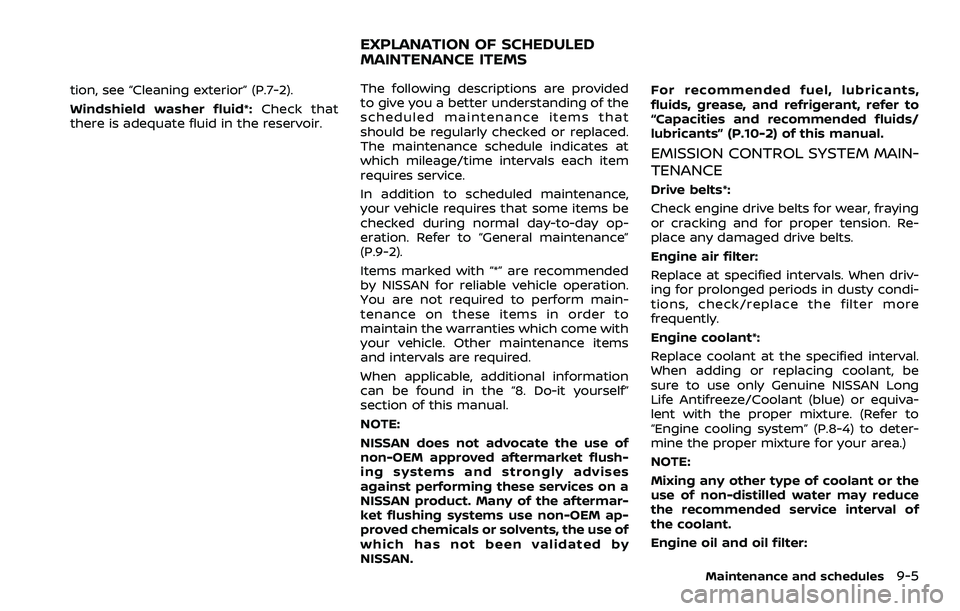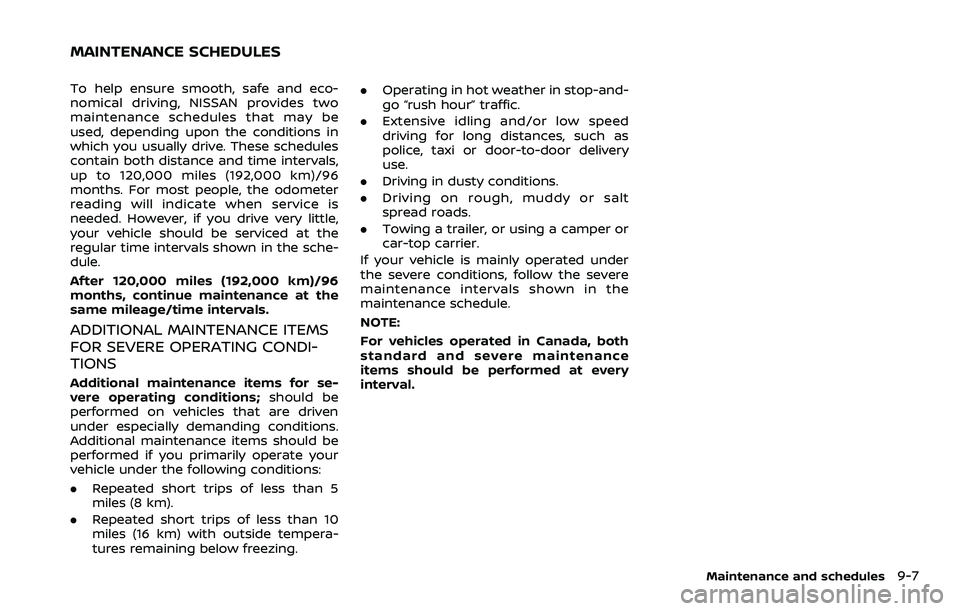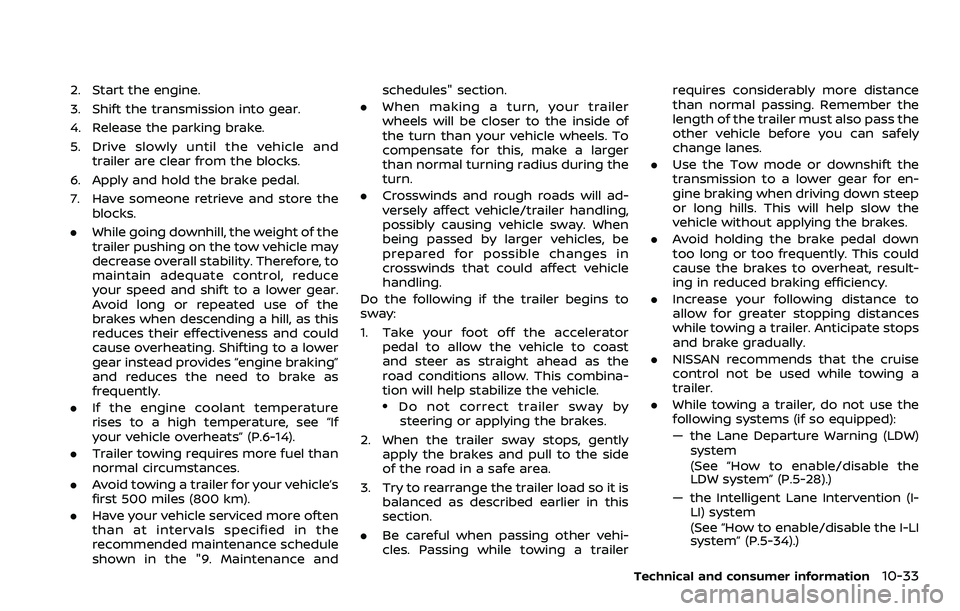2022 NISSAN ARMADA service schedule
[x] Cancel search: service schedulePage 536 of 604

9-4Maintenance and schedules
belt system (for example, buckles, an-
chors, adjuster and retractors) operate
properly and smoothly, and are installed
securely. Check the belt webbing for cuts,
fraying, wear or damage.
Steering wheel:Check for changes in the
steering conditions, such as excessive
free play, hard steering or strange noises.
Warning lights and chimes: Make sure
that all warning lights and chimes are
operating properly.
Windshield defroster: Check that the air
comes out of the defroster outlets prop-
erly and in sufficient quantity when oper-
ating the heater or air conditioner.
Windshield wiper and washer*: Check
that the wipers and washer operate
properly and that the wipers do not
streak.
Under the hood and vehicle
The maintenance items listed here should
be checked periodically (for example,
each time you check the engine oil or
refuel).
Battery*: Check the fluid level in each cell.
It should be between the MAX and MIN
lines. Vehicles operated in high tempera-
tures or under severe condition require
frequent checks of the battery fluid level. NOTE:
Care should be taken to avoid situations
that can lead to potential battery dis-
charge and potential no-start condi-
tions such as:
1.
Installation or extended use of elec-
tronic accessories that consume
battery power when the engine is
not running (Phone chargers, GPS,
DVD players, etc.)
2. Vehicle is not driven regularly and/
or only driven short distances.
In these cases, the battery may need to
be charged to maintain battery health.
Brake fluid level*: Make sure that the
brake fluid level is between the MAX and
MIN lines on the reservoir.
Engine coolant level*: Check the coolant
level when the engine is cold.
Engine drive belts*: Make sure that no
belt is frayed, worn, cracked or oily.
Engine oil level*: Check the level after
parking the vehicle on a level spot and
turning off the engine. Wait more than 15
minutes for the oil to drain back into the
oil pan.
Exhaust system: Make sure there are no
loose supports, cracks or holes. If the
sound of the exhaust seems unusual or
there is a smell of exhaust fumes, im-
mediately have the exhaust system in- spected. It is recommended you visit a
NISSAN dealer for this service. (See “Pre-
cautions when starting and driving” (P.5-
4) for exhaust gas (carbon monoxide).)
Fluid leaks:
Check under the vehicle for
fuel, oil, water or other fluid leaks after the
vehicle has been parked for a while. Water
dripping from the air conditioner after use
is normal. If you should notice any leaks
or if gasoline fumes are evident, check for
the cause and have it corrected immedi-
ately.
Power steering fluid level* and lines:
Check the level when the fluid is cold, with
the engine off. Check the lines for proper
attachment, leaks, cracks, etc.
Radiator and hoses: Check the front of
the radiator and clean off any dirt, insects,
leaves, etc., that may have accumulated.
Make sure the hoses have no cracks,
deformation, rot or loose connections.
Underbody: The underbody is frequently
exposed to corrosive substances such as
those used on icy roads or to control
dust. It is very important to remove these
substances, otherwise rust will form on
the floor pan, frame, fuel lines and around
the exhaust system. At the end of winter,
the underbody should be thoroughly
flushed with plain water, being careful to
clean those areas where mud and dirt
may accumulate. For additional informa-
Page 537 of 604

tion, see “Cleaning exterior” (P.7-2).
Windshield washer fluid*:Check that
there is adequate fluid in the reservoir.The following descriptions are provided
to give you a better understanding of the
scheduled maintenance items that
should be regularly checked or replaced.
The maintenance schedule indicates at
which mileage/time intervals each item
requires service.
In addition to scheduled maintenance,
your vehicle requires that some items be
checked during normal day-to-day op-
eration. Refer to “General maintenance”
(P.9-2).
Items marked with “*” are recommended
by NISSAN for reliable vehicle operation.
You are not required to perform main-
tenance on these items in order to
maintain the warranties which come with
your vehicle. Other maintenance items
and intervals are required.
When applicable, additional information
can be found in the “8. Do-it yourself”
section of this manual.
NOTE:
NISSAN does not advocate the use of
non-OEM approved aftermarket flush-
ing systems and strongly advises
against performing these services on a
NISSAN product. Many of the aftermar-
ket flushing systems use non-OEM ap-
proved chemicals or solvents, the use of
which has not been validated by
NISSAN. For recommended fuel, lubricants,
fluids, grease, and refrigerant, refer to
“Capacities and recommended fluids/
lubricants” (P.10-2) of this manual.
EMISSION CONTROL SYSTEM MAIN-
TENANCE
Drive belts*:
Check engine drive belts for wear, fraying
or cracking and for proper tension. Re-
place any damaged drive belts.
Engine air filter:
Replace at specified intervals. When driv-
ing for prolonged periods in dusty condi-
tions, check/replace the filter more
frequently.
Engine coolant*:
Replace coolant at the specified interval.
When adding or replacing coolant, be
sure to use only Genuine NISSAN Long
Life Antifreeze/Coolant (blue) or equiva-
lent with the proper mixture. (Refer to
“Engine cooling system” (P.8-4) to deter-
mine the proper mixture for your area.)
NOTE:
Mixing any other type of coolant or the
use of non-distilled water may reduce
the recommended service interval of
the coolant.
Engine oil and oil filter:
Maintenance and schedules9-5
EXPLANATION OF SCHEDULED
MAINTENANCE ITEMS
Page 539 of 604

To help ensure smooth, safe and eco-
nomical driving, NISSAN provides two
maintenance schedules that may be
used, depending upon the conditions in
which you usually drive. These schedules
contain both distance and time intervals,
up to 120,000 miles (192,000 km)/96
months. For most people, the odometer
reading will indicate when service is
needed. However, if you drive very little,
your vehicle should be serviced at the
regular time intervals shown in the sche-
dule.
After 120,000 miles (192,000 km)/96
months, continue maintenance at the
same mileage/time intervals.
ADDITIONAL MAINTENANCE ITEMS
FOR SEVERE OPERATING CONDI-
TIONS
Additional maintenance items for se-
vere operating conditions;should be
performed on vehicles that are driven
under especially demanding conditions.
Additional maintenance items should be
performed if you primarily operate your
vehicle under the following conditions:
. Repeated short trips of less than 5
miles (8 km).
. Repeated short trips of less than 10
miles (16 km) with outside tempera-
tures remaining below freezing. .
Operating in hot weather in stop-and-
go “rush hour” traffic.
. Extensive idling and/or low speed
driving for long distances, such as
police, taxi or door-to-door delivery
use.
. Driving in dusty conditions.
. Driving on rough, muddy or salt
spread roads.
. Towing a trailer, or using a camper or
car-top carrier.
If your vehicle is mainly operated under
the severe conditions, follow the severe
maintenance intervals shown in the
maintenance schedule.
NOTE:
For vehicles operated in Canada, both
standard and severe maintenance
items should be performed at every
interval.
Maintenance and schedules9-7
MAINTENANCE SCHEDULES
Page 587 of 604

2. Start the engine.
3. Shift the transmission into gear.
4. Release the parking brake.
5. Drive slowly until the vehicle andtrailer are clear from the blocks.
6. Apply and hold the brake pedal.
7. Have someone retrieve and store the blocks.
. While going downhill, the weight of the
trailer pushing on the tow vehicle may
decrease overall stability. Therefore, to
maintain adequate control, reduce
your speed and shift to a lower gear.
Avoid long or repeated use of the
brakes when descending a hill, as this
reduces their effectiveness and could
cause overheating. Shifting to a lower
gear instead provides “engine braking”
and reduces the need to brake as
frequently.
. If the engine coolant temperature
rises to a high temperature, see “If
your vehicle overheats” (P.6-14).
. Trailer towing requires more fuel than
normal circumstances.
. Avoid towing a trailer for your vehicle’s
first 500 miles (800 km).
. Have your vehicle serviced more often
than at intervals specified in the
recommended maintenance schedule
shown in the "9. Maintenance and schedules" section.
. When making a turn, your trailer
wheels will be closer to the inside of
the turn than your vehicle wheels. To
compensate for this, make a larger
than normal turning radius during the
turn.
. Crosswinds and rough roads will ad-
versely affect vehicle/trailer handling,
possibly causing vehicle sway. When
being passed by larger vehicles, be
prepared for possible changes in
crosswinds that could affect vehicle
handling.
Do the following if the trailer begins to
sway:
1. Take your foot off the accelerator pedal to allow the vehicle to coast
and steer as straight ahead as the
road conditions allow. This combina-
tion will help stabilize the vehicle.
.Do not correct trailer sway bysteering or applying the brakes.
2. When the trailer sway stops, gently apply the brakes and pull to the side
of the road in a safe area.
3. Try to rearrange the trailer load so it is balanced as described earlier in this
section.
. Be careful when passing other vehi-
cles. Passing while towing a trailer requires considerably more distance
than normal passing. Remember the
length of the trailer must also pass the
other vehicle before you can safely
change lanes.
. Use the Tow mode or downshift the
transmission to a lower gear for en-
gine braking when driving down steep
or long hills. This will help slow the
vehicle without applying the brakes.
. Avoid holding the brake pedal down
too long or too frequently. This could
cause the brakes to overheat, result-
ing in reduced braking efficiency.
. Increase your following distance to
allow for greater stopping distances
while towing a trailer. Anticipate stops
and brake gradually.
. NISSAN recommends that the cruise
control not be used while towing a
trailer.
. While towing a trailer, do not use the
following systems (if so equipped):
— the Lane Departure Warning (LDW)
system
(See “How to enable/disable the
LDW system” (P.5-28).)
— the Intelligent Lane Intervention (I- LI) system
(See “How to enable/disable the I-LI
system” (P.5-34).)
Technical and consumer information10-33
Page 595 of 604

11 Index
A
ABS (Anti-lock Braking System) .................... 5-143
Advanced Air Bag System .................................... 1-61
Air bag systemAdvanced Air Bag System ............................. 1-61
Driver and front passenger
supplemental knee air bag system ....... 1-69
Front passenger air bag and
status light................................................................. 1-63
Front-seat mounted side-impact
supplemental air bag system..................... 1-71
Roof-mounted curtain side-impact
and rollover supplemental air
bag system................................................................ 1-71
Air bag warning labels ............................................ 1-73
Air bag warning light................................. 1-74, 2-14
Air cleaner housing filter ....................................... 8-15
Air conditioner Air conditioner operation............................... 4-37
Air conditioner service...................................... 4-43
Air conditioner specification label....... 10-13
Air conditioning system refrigerant
and lubricant recommendations............. 4-43
Air conditioning system refrigerant
and oil recommendations ............................. 10-7
Automatic air conditioner ............................. 4-38
In-cabin microfilter .............................................. 4-43
Alarm, How to stop alarm (see vehicle
security system)............................................................ 2-41
Alcohol, drugs and driving ................................... 5-10
Alert Rear Door Alert....................................................... 2-61
All-mode 4WD.............................................................. 5-124
Android Auto ....................................................................... 4-3 Antenna........................................................................\
....... 4-43
Anti-lock Braking System (ABS) .................... 5-143
Anti-lock Braking System (ABS)
warning light ................................................................... 2-15
Appearance care
Exterior appearance care ................................. 7-2
Interior appearance care................................... 7-5
Apple CarPlay®................................................................... 4-3
Armrest ........................................................................\
........ 1-11
Audible reminders....................................................... 2-20
Auto closure .................................................................... 3-25
Autolight system.......................................................... 2-48
Automatic Air conditioner ........................................................ 4-38
Automatic Transmission Fluid (ATF) ........ 8-8
Door locks...................................................................... 3-6
Drive positioner...................................................... 3-40
Driving with
automatic transmission .................................. 5-18
Seat positioner ....................................................... 3-40
Automatic Emergency Braking (AEB)
system warning light................................................ 2-15
Automatic Emergency Braking (AEB) with
pedestrian detection system ............................. 5-96
Average speed ............................................................... 2-37
Avoiding collision and rollover.............................. 5-8
B
Back door (See liftgate) .......................................... 3-22
Battery........................................................................\
.......... 8-11 Battery saver system.......................... 2-52, 2-80
Intelligent Key.......................................................... 8-21
Variable voltage control system .............. 8-13
Before starting the engine................................... 5-16
Belts (See drive belts)............................................... 8-13 Blind Spot Warning (BSW) ..................................... 5-38
Booster seats.................................................................. 1-51
Brake
Anti-lock Braking System (ABS) ............ 5-143
Brake booster.......................................................... 8-17
Brake fluid ..................................................................... 8-9
Brake system ....................................................... 5-142
Parking brake operation................................. 5-22
Warning light............................................................ 2-12
Break-in schedule .................................................... 5-122
Brightness control Instrument panel .................................................. 2-53
Bulb check/instrument panel............................ 2-12
Bulb replacement ........................................................ 8-24
C
Cabin air filter ................................................................. 4-43
Camera aiding sonar function.......................... 4-26
Capacities and
recommended fluids/lubricants...................... 10-2
Car phone or CB radio ............................................ 4-44
Cargo floor box ............................................................. 2-74
Cargo light ........................................................................\
2-83
Catalytic converter, Three way catalyst ....... 5-4
Charger Wireless charger .................................................... 2-65
Child restraints .............................................................. 1-32 Booster seats........................................................... 1-51
LATCH system ......................................................... 1-35
Precautions on child restraints................. 1-33
Top tether strap .................................................... 1-37
Child safety....................................................................... 1-30
Child safety rear door lock ...................................... 3-6
Chimes
Audible reminders................................................ 2-20
Page 598 of 604

11-4
Engine serial number .................................... 10-12
F.M.V.S.S./C.M.V.S.S.
certification label .............................................. 10-12
Tire and Loading
information label................................ 8-30, 10-13
Vehicle identification number (VIN) .... 10-11
Lane Departure Warning (LDW) ........................ 5-26
LATCH system ................................................................ 1-35
License plate, Installing front
license plate.................................................................. 10-15
Liftgate........................................................................\
......... 3-22
Light Air bag warning light......................................... 1-74
Bulb replacement ................................................. 8-24
Cargo light ................................................................. 2-83
Fog light switch ..................................................... 2-54
Headlight switch ................................................... 2-47
Headlights bulb replacement ..................... 8-25
Indicator lights........................................................ 2-15
Interior light switch............................................. 2-81
Interior lights............................................................ 2-81
Map lights ................................................................... 2-82
Replacement ............................................................ 8-24
Vanity mirror lights ............................................. 2-83
Warning/indicator lights and
audible reminders ................................................ 2-12
Lights, Exterior and interior
light replacement ........................................................ 8-26
Linking Intelligent Key (air conditioner)..... 4-43
Loading information (See vehicle
loading information) .............................................. 10-15
Lock Automatic door locks........................................... 3-6
Door locks...................................................................... 3-4
Liftgate lock .............................................................. 3-22
Power door lock ....................................................... 3-4
Locking with mechanical key ................................ 3-4 Loose Fuel Cap warning........................................ 3-26
Low tire pressure warning light ...................... 2-16
Low tire pressure warning system
(See Tire Pressure Monitoring
System (TPMS)).................................................................. 5-5
Luggage hooks ............................................................. 2-73
M
Maintenance........................................................................\
9-2
Battery........................................................................\
... 8-11
General maintenance........................................... 9-2
Inside the vehicle..................................................... 9-3
Maintenance precautions................................. 8-2
Maintenance requirements ............................. 9-2
Maintenance schedules...................................... 9-7
Outside the vehicle ................................................ 9-2
Seat belt maintenance..................................... 1-29
Maintenance schedules.............................................. 9-7
Malfunction Indicator Light (MIL) .................... 2-18
Map lights ........................................................................\
.. 2-82
Master warning light.................................. 2-14, 2-18
Mechanical key (Intelligent Key system) ....... 3-3
Memory seat ................................................................... 3-40
Memory storage, memory seat........................ 3-41
Meter Trip computer ......................................................... 2-37
Meters and gauges ........................................................ 2-6 Instrument brightness control .................. 2-53
Mirror Inside mirror ............................................................. 3-30
Intelligent Rear View Mirror.......................... 3-31
Outside mirrors ...................................................... 3-38
Vanity mirror ............................................................ 3-40
Monitor Intelligent Around View® Monitor............ 4-12
Monitor, RearView Monitor ...................................... 4-4 Moonroof........................................................................\
.... 2-78
Moving Object Detection (MOD) ...................... 4-31
N
New vehicle break-in ............................................. 5-122
NISSAN all-mode 4WD®........................................ 5-124
NISSAN Vehicle Immobilizer System ............ 2-41
NissanConnect® Owner’s Manual....................... 4-3
O
Odometer........................................................................\
....... 2-7
Off-road recovery ............................................................ 5-9
Oil
Capacities and
recommended fluids/lubricants............... 10-2
Changing engine oil and filter ...................... 8-6
Checking engine oil level................................... 8-6
Engine oil.....................................................................\
... 8-6
Engine oil pressure gauge ............................... 2-9
Engine oil viscosity .............................................. 10-7
Operation, operational indicators .................. 2-30
Other lights....................................................................... 2-19
Outside air temperature ........................................ 2-39
Outside mirrors ............................................................. 3-38
Overheat, If your vehicle overheats.............. 6-14
Owner’s Manual/Service Manual
order information..................................................... 10-40
P
Panic alarm....................................................................... 3-17
Parking Brake break-in .................................................... 5-142
Parking brake operation................................. 5-22
Parking on hills................................................... 5-133